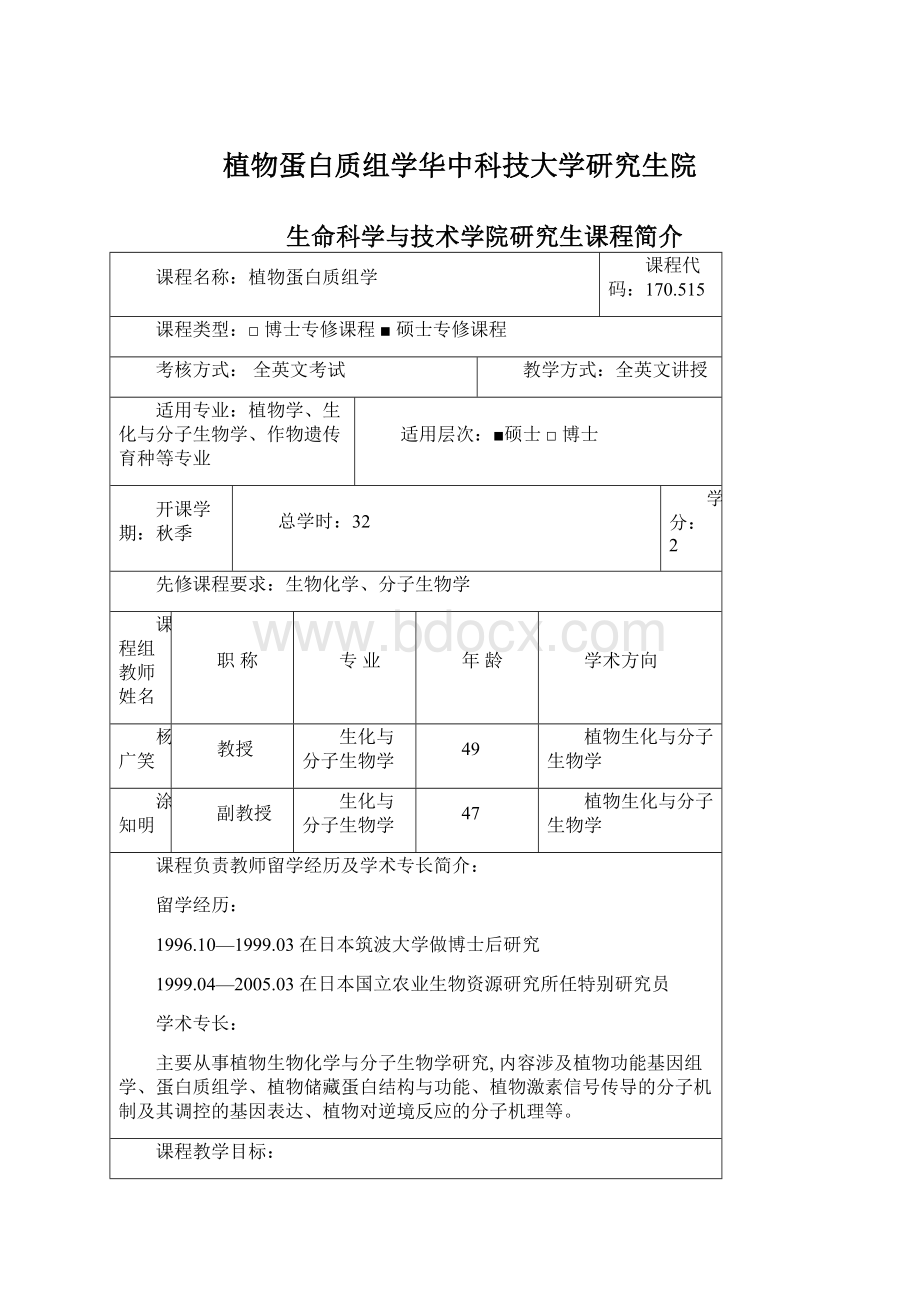植物蛋白质组学华中科技大学研究生院Word文档格式.docx
《植物蛋白质组学华中科技大学研究生院Word文档格式.docx》由会员分享,可在线阅读,更多相关《植物蛋白质组学华中科技大学研究生院Word文档格式.docx(9页珍藏版)》请在冰豆网上搜索。

专业
年龄
学术方向
杨广笑
教授
生化与分子生物学
49
植物生化与分子生物学
涂知明
副教授
47
课程负责教师留学经历及学术专长简介:
留学经历:
1996.10—1999.03在日本筑波大学做博士后研究
1999.04—2005.03在日本国立农业生物资源研究所任特别研究员
学术专长:
主要从事植物生物化学与分子生物学研究,内容涉及植物功能基因组学、蛋白质组学、植物储藏蛋白结构与功能、植物激素信号传导的分子机制及其调控的基因表达、植物对逆境反应的分子机理等。
课程教学目标:
蛋白质组学是二十世纪九十年代中期诞生的一门新兴学科,是新世纪生命科学研究的前沿,是应用大规模蛋白质分离和识别技术研究蛋白质组及蛋白质间相互作用的一门学科。
本课程着重讲授植物蛋白质组学的基本原理和研究方法,同时介绍植物蛋白质组学研究领域的最新进展。
通过本课程的学习,使学生了解并初步掌握植物蛋白质大规模分离、鉴定以及蛋白质间相互的研究手段和实验方法。
课程大纲:
(章节目录)
第一章绪论
§
1.1蛋白质组学概念的提出
1.2蛋白质组学与基因组学的联系与区别
1.3植物蛋白质组学的研究意义和内容
1.4植物蛋白质组学的研究现状和发展趋势
第二章蛋白质组学的研究方法
2.1概述
2.2大规模蛋白质分离技术
2.3高通量蛋白质鉴定技术
第三章植物蛋白质提取方法
3.1概述
3.2TCA-丙酮法提取植物全蛋白质技术
3.3顽拗植物蛋白质提取技术
3.4木本植物蛋白质提取技术
3.5植物种子蛋白质提取技术
3.6植物细胞器蛋白质提取技术
第四章蛋白质的分离技术
4.1一维等电聚焦电泳
4.2Blue-Native凝胶技术分析植物蛋白质复合物
4.3二维SDS—聚丙烯酰胺凝胶电泳
4.4胶上蛋白的检测
4.5存在问题
第五章蛋白质组研究中的图像分析与蛋白谱数据库的建立
5.1蛋白电泳图像分析系统
5.2实用软件简介
5.3二维电泳蛋白谱数据库
第六章蛋白质测序仪与蛋白质的鉴定
6.1原理
6.2蛋白质序列分析仪和质谱仪优缺点比较
6.3样品制备
6.4分析与数据检索
第七章基质辅助激光解吸电离飞行时间质谱
7.1MALDI离子源
7.2线性飞行时间质量检测器
7.3反射飞行时间质量检测器
7.4样品制备方法
第八章液相色谱—电喷雾—串联质谱
8.1电喷雾电离源
8.2串联质谱
第九章肽质量指纹谱鉴定蛋白质技术
9.1肽质量指纹谱鉴定蛋白质原理
9.2凝胶电泳分离蛋白质PMF鉴定方法
9.3凝胶电泳分离蛋白质PMF鉴定方法实例
第十一章肽序列标签与蛋白质从头测序技术
10.1串联质谱测定多肽序列原理
10.2串联质谱分析肽段序列原理
10.3肽序列标签鉴定技术
10.4PDS质谱数据库检索鉴定技术
10.5从头测序技术
第十一章植物磷酸化蛋白质的鉴定
11.1磷酸化蛋白质分析概述
11.2磷酸化蛋白质的检测
11.3蛋白质磷酸化位点的分析
11.4蛋白质磷酸化的定量分析
第十二章植物糖基化蛋白质的鉴定
12.1糖蛋白的结构特征
12.2生物质谱技术鉴定糖蛋白
12.3糖蛋白与蛋白质组学
第十三章利用荧光染料进行定量的植物蛋白质组分析技术
13.1二维电泳凝胶的荧光染色
13.2蛋白质样品的荧光标记与分离
13.3图像分析与数据定量
第十四章利用荧光染料进行定量的植物蛋白质组分析技术
14.1运用质谱进行定量的植物蛋白质组分析技术
14.2稳定同位素代谢标记技术
14.3同位素亲和标签技术
第十五章植物蛋白质组研究中的生物信息学
15.1生物信息学简介
15.2数据库的构建
15.3植物蛋白质组研究中常用的网站及数据库
全英文教材:
PlantProteomics,MethodsandProtocols.in:
METHODSINMOLECULARBIOLOGY,355,EditedbyHervé
Thiellement;
MichelZivy;
CatherineDamerval;
Valé
rieMé
chin.HumanPress,2007.
主要参考书:
1.Proteomics:
Fromproteinsequencetofunction.EdsS.Pennington&
M.Dunn.2001.BIOSScientificPublishers
2.蛋白质组学:
理论与方法,钱小红、贺福初主编,2003年6月,科学出版社出版。
3.国内外相关期刊杂志。
SyllabusofGraduateCoursesinEnglish
inCollegeofLifeScienceandTechnology
CourseName:
PlantProteomics
CourseCode:
CourseType:
□ForDoctoralStudents■ForMasterStudents
Assessment:
ExaminationinEnglish
TeachingLanguage:
English
ForMajors:
Botany,Biochemistry&
MolecularBiology,CropGeneticBreeding
Level:
■Master□Doctoral
Semester:
Fall
CreditHours:
Credits:
2
PrerequisiteCourses:
Biochemistry,MolecularBiology
Teachers
Title
Major
Age
ResearchInterests
GuangxiaoYang
Prof.
Biochem.&
MolBiol
PlantBiochem.
&
Mol.Biol.
ZhimingTu
AssociateProf.
OverseaExperienceandAcademicExpertiseoftheCoursePrincipalInstructor:
1996.10—1999.03:
UniversityofTsukuba,JapanDept.ofBiologicalScience
Postdoctoralfellow
1999.04—2005.03:
NationalInstituteofAgrobiologicalResource,Japan,Dept.OfMolecularGenetics,ResearchScientist
Researchinterests:
Understandinghowplantsadapttoenvironmentalstressessuchasdrought,salinity,highandlowtemperaturethatresultinheavycropyieldlosses.Weareusinggenomics,proteomics,biochemical,physiologicalandbioinformaticsapproachestoelucidatethemechanismsinvolvedinabioticstresstoleranceincerealssuchaswheatandrice.Researchinterestsalsoincludephytohormonesignalingandregulatedgeneexpression,therelationshipsbetweenthestructureofstorageproteinandwheatmillingbreadmakingquality.
CourseObjectives:
Proteomics,borninthemiddleofnineties,twentiethcentury,isanewemergingdisciplineandthefrontieroflifescienceresearch.Proteomicsisdefinedastostudyproteomeandprotein-proteininteractionwithapplicationoflarge-scaleproteinseparationandidentificationtechniques.Thiscoursefocusesonthebasicprinciplesandmethodsinplantproteomics,andatthesametime,introducesthelatestadvancesinthefieldofplantproteomics.Itaimstomakestudentsunderstandandmastertheresearchmethodandexperimentaltechnologiesincludinglargescaleproteinseparation,identificationandprotein-proteininteractions.
CourseOutline:
Chapter1Introduction
§
1.1Conceptinproteomics
1.2Relationanddifferencebetweenproteomicsandgenomics
1.3Significanceandcontentsofplantproteomicsresearch
1.4Currentsituationanddevelopmenttendencyinplantproteomicsresearch
Chapter2MethodologyinProteomicsResearch
2.1Outline
2.2Largescaleproteinseparation
2.3High-throughputproteinidentificationtechnology
Chapter3ProteinExtractionfromPlantMaterials
3.1Outline
3.2TotalproteinextractionwithTCA-Acetone
3.3ExtractionofproteinsfromRecalcitrantplanttissues
3.4Extractionofproteinsfromwoodyplanttissues
3.5Extractionofproteinsfromseeds
3.6Extractionofproteinsfromplantcellorganelles
Chapter4ProteinSeparationTechnology
4.1Onedimensionalisoelectricfocusingelectrophoresis
4.2Blue-nativegeltechniquefortheanalysisofplantproteincomplexes
4.3TwodimensionalSDS-polyacrylamidegelelectrophoresis
4.4Proteinspotdetectionongel.
4.5Trubleshooting
Chapter5Imageanalysisandproteinprofilingdatabaseestablishment
5.1Proteinelectrophoresisimageanalysissystem
5.2Softwareutility
5.3Two-dimensionalelectrophoresisofproteinspectrumdatabase
Chapter6ProteinSequencingandProteinIdentification
6.1Principles
6.2Comparisonofadvantagesanddisadvantagesofproteinsequencerandmassspectrometer
6.3Samplepreparation
6.4Analysisanddataretrieval
Chapter7Matrixassistedlaserdesorptionionizationtimeofflightmassspectrometry
7.1MALDIioniztionsource
7.2Lineartimeofflightmassdetector
7.3Reflectiontimeofflightmassdetector
7.4Samplepreparation
Chapter8Liquidchromatography-electrosprayionizationtandemmassspectrometry
8.1Theelectrosprayionizationsource
8.2Tandemmassspectrometry
Chapter9Peptidemassfingerprintingfortheidentificationofprotein
9.1Principleofpeptidemassfingerprintingfortheidentificationofproteins
9.2GelelectrophoresisforproteinseparationandPMFidentification
9.3Casestudy
Chapter10Peptidesequencetagandfordenovoproteinsequencing
10.1Principleoftandemmassspectrometryforthedeterminationofpolypeptidesequence
10.2Peptidesequencetagidentificationtechnology
10.3PDSmassspectrometrydatabaseretrievalidentification
10.4Denovoproteinsequencing
Chapter11Plantphosphoproteinidentification
11.1Overviewonphosphoproteomeanalysis
11.2Detectionofphosphorylatedproteins
11.3Proteinphosphorylationsiteanalysis
11.4Quantitativeanalysisofproteinphosphorylation
Chapter12Glycoproteinsidentificationinplants
12.1Structuralcharacterizationofglycoproteins
12.2Biomassspectrometryidentificationofglycoprotein
12.3Glycoproteinandproteomics
Chapter13Usingthefluorescentdyeforquantitativeplantproteomeanalysis
13.1Fluorescentstainingfortwodimensionalgelelectrophoresis
13.2Fluorescencelabelingandseparationofproteins
13.3Imageanalysisandquantitativedata
Chapter14Usingmassspectrometryforquantitativeplantproteomeanalysis
14.1Stableisotopemetaboliclabelingtechnique
14.2Isotopecodedaffinitytagtechnology
Chapter15Bioinformaticsinplantproteomeresearch
15.1IntroductiontoBioinformatics
15.2Databaseconstruction
15.3Webanddatabasecommonlyusedinplantproteomeresearch
Textbook
PlantProteomics,MethodsandProtocols.in:
chin.HumanPress,2007.
References:
1.Proteomics:
Theory&
Method.EdsXiaohongQian&
FuchuHe.2003.SciencePress.Beijing(InChinese).
2.Proteomics:
3.AllrelatedJournals.